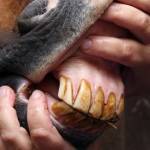Regular Dental Care Important for Digestion in Horses

The digestive process begins when the horse takes food into its mouth. In order to start the digestive process properly, the horse needs a sound, functional mouth. This means the teeth should be healthy with surfaces that meet squarely.
The mature horse has 18 upper and 18 lower teeth consisting of six upper and six lower incisors and 12 upper and lower molars. The function of the teeth is prehension (gathering) and chewing of food, which may be supplied as fresh pasture, long-stem hay or variations of forage, and concentrate feeds containing processed or unprocessed cereal grains. The teeth participate in the digestive process primarily by reducing the particle size of food.
Chewing stimulates the flow of saliva, which may initiate chemical digestion of feed. Saliva also lubricates chewed material so it can pass smoothly down the esophagus to the stomach.
Dental problems resulting from wear and genetic defects such as parrot mouth interfere with dental function. Many times, horses that waste feed, bolt their feed, or are finicky eaters have dental anomalies that, once corrected, will allow the horse to utilize feed more efficiently.
Examination of the teeth should be an integral part of the nutritional management program on a farm. Horses should have dental examinations once or twice a year and should have their teeth floated (filed) if sharp edges are detected. These “hooks” are most commonly found on the upper cheek side or lower tongue side of the molar arcades. Other corrections may be needed to repair broken teeth and restore normal alignment.
Older horses that have lost functional dentition through normal wear, or younger horses with dental problems, may benefit from the use of pelleted concentrate rations since the particle size has been mechanically reduced in the pelleting process.








